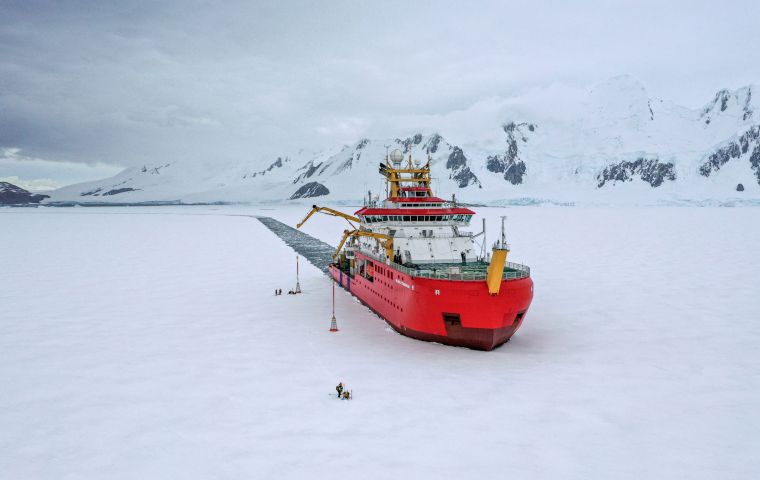MercoPress. South Atlantic News Agency
BAS has launched its Antarctic field season with an ambitious range of projects
 RRS Sir David Attenborough will be deploying scientific instruments, along with undertaking sea-ice and ocean observations.
RRS Sir David Attenborough will be deploying scientific instruments, along with undertaking sea-ice and ocean observations. The British Antarctic Survey, BAS, Antarctic field season has begun, with a challenging and ambitious range of projects to be delivered at five BAS research stations and across the wider continent. Over 500 people are working in Antarctica this season on BAS research stations, on RRS Sir David Attenborough, in the field and in collaboration with other Antarctic operators.
Through our expert Operations Team, we help deliver world-class field science that informs policy-makers and governments on some of today’s major issues, including at international committees and stakeholder meetings such as COP 27.
Professor Dame Jane Francis, Director of British Antarctic Survey said: “We continue to work in collaboration with scientists from institutions across the globe to help further our understanding of the frozen continent and beyond.
There’s a wide variety of exciting projects this field season. An example is testing the HABIT scientific instrument bound for Mars at our Sky-Blu Field Station, as Antarctica has the closest conditions to the red planet. After two extremely challenging years due to Covid, we look forward to a busy summer program of science in Antarctica.”
We are committed to reducing our carbon emissions and reaching net zero by 2040. For the first time in Antarctica this season, we will be testing a new autonomous aircraft system, the Prion. It can support a range of science and provide data at a fraction of the carbon emissions compared to existing aerial science platforms, such as the Twin Otter aircraft.
We collaborate with scientists from across the world to address the big science questions of our time. The International Thwaites Glacier Collaboration (ITGC) is the largest US-UK science project undertaken in Antarctica in the last 70 years. Thwaites Glacier is the size of Great Britain, and its rapid melting is causing widespread concern; it could contribute several centimeters to sea-level rise by the end of the century. A range of projects take place this season that will provide data to enable robust projections around the future of this critical area of West Antarctica.
Rothera Research Station
Over 10 projects are taking place this season at Rothera Research Station, the largest British Antarctic facility. Long-term monitoring continues on a number of projects, including surveying the ice ramp and monitoring the seabed adjacent to the station.
For the second season, the new Rothera Clean Air Facility will be taking ground-based measurements, along with the Twin Otter aircraft taking aerial measurements directly inside clouds as part of the project on Southern Ocean Clouds. There will also be research into how crab-eater seals are responding to ongoing environmental change in the western Antarctica Peninsula in a joint UKRI-NERC-NSF-funded project.
Halley VI Research Station
Since the calving of several large icebergs from the Brunt Ice Shelf in 2021, monitoring on the most-observed ice shelf on Earth continues to help us understand any risk to our operations and infrastructure.
The Antarctic Ozone Hole, first discovered in 1985 by BAS scientists at Halley Research Station, will be examined using the automated Dobson spectrophotometer and SAOZ instrument to measure stratospheric ozone.
Developments on the Halley Automation Project continue this season to provide power for experiments and scientific data when the station is not occupied through the winter period.
King Edward Point (KEP) Research Station
Several wildlife surveys on whales, fur seals, gentoo penguins, fish larvae and ground fish will be carried out this season to create long-term datasets to understand population changes.
Seabirds are among the most globally-threatened birds, as a consequence of by-catch in fishing and South Georgia holds important populations of white-chinned petrels. Tracking devices will be deployed at Bird Island and KEP to provide data during the breeding and non-breeding season.
Bird Island Research Station
Our long-term science project on marine predators continues this season, providing scientists and conservationists with indicators of change in the Scotia Sea and elsewhere in the south-west Atlantic. Research will include the survival and breeding histories of wandering, black-browed and grey-headed albatrosses, along with northern and southern giant petrels, macaroni penguins and Antarctic fur and leopard seals. We will also monitor population and breeding success of light-mantled albatrosses and gentoo penguins.
Signy Research Station
A variety of science projects will take place this season. Chinstrap penguins will be tracked from multiple colonies from the South Orkneys and South Shetlands to help understand migration paths.
The midge Belgica Antarctica is the southernmost free-living insect and a new study will help to identify population and species-level adaptions.
Long-term monitoring continues on seals, penguins and flying seabirds, along with bivalves to understand key drivers of environmental variability and to predict future changes in Antarctic ecosystems.
RRS Sir David Attenborough and Dash 7 aircraft
The DEFIANT project aims to understand the atmospheric and oceanic processes controlling seasonal and longer-term trends in sea ice in the Southern Ocean around Antarctica. The project will use our polar ship, RRS Sir David Attenborough, and polar aircraft, Dash 7, for research.
RRS Sir David Attenborough will be deploying scientific instruments, along with undertaking sea-ice and ocean observations. The ship will also be conducting polar water trials, another critical step in its commissioning. These trials will involve testing the trace metal systems and deploying scientific instruments in deep and polar waters, where it is much colder and rougher than the waters around the UK where initial science trials took place earlier this year.
The Dash 7 will be flying for science, fitted with a wide range of science sensors, including radar, lidar, cameras, gravimeters and radiometers.




Top Comments
Disclaimer & comment rulesCommenting for this story is now closed.
If you have a Facebook account, become a fan and comment on our Facebook Page!